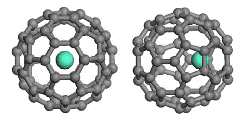Chemistry, Department of: Faculty Series

Xiao Cheng Zeng Publications
Multiple Wetting−Dewetting States of a Water Droplet on Dual- Scale Hierarchical Structured Surfaces
Document Type
Article
Date of this Version
6-24-2021
Citation
JACS Au 2021, 1, 955−966. https://doi.org/10.1021/jacsau.1c00183
Abstract
Surfaces with microscale roughness can entail dualscale hierarchical structures such as the recently reported nano/ microstructured surfaces produced in the laboratory (Wang et al. Nature 2020, 582, 55−57). However, how the dual-scale hierarchical structured surface affects the apparent wetting/ dewetting states of a water droplet, and the transitions between the states are still largely unexplored. Here, we report a systematic large-scale molecular dynamics (MD) simulation study on the wetting/dewetting states of water droplets on various dual-scale nano/near-submicrometer structured surfaces. To this end, we devise slab-water/slab-substrate model systems with a variety of dual-scale surface structures and with different degrees of intrinsic wettability (as measured based on the counterpart smooth surface). The dual-scale hierarchical structure can be described as “nanotexture-on-near-submicrometer-hill”. Depending on three prototypical nanotextures, our MD simulations reveal five possible wetting/dewetting states for a water droplet: (i) Cassie state; (ii) infiltrated upper-valley state; (iii) immersed nanotexture-on-hill state; (iv) infiltrated valley state; and (v) Wenzel state. The transitions between these wetting/dewetting states are strongly dependent on the intrinsic wettability (Ein), the initial location of the water droplet, the height of the nanotextures (H1), and the spacing between nanotextures (W1). Notably, Ein−H1 and Ein−W1 diagrams show that regions of rich wetting/dewetting states can be identified, including regions where between one to five states can coexist.


Comments
Used by permission.